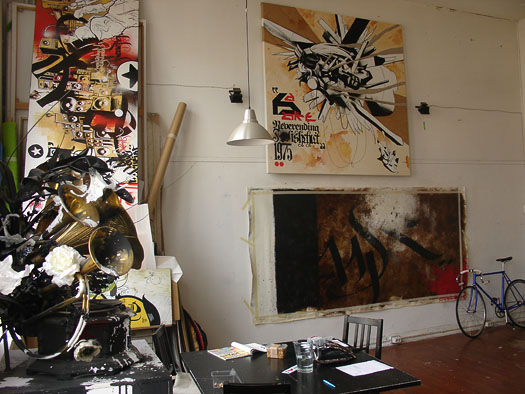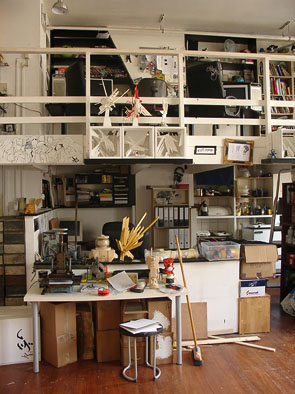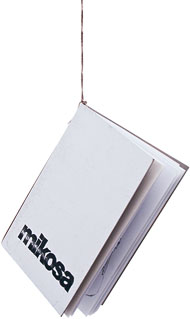




top: The Two Things work space.
middle: Mikosa exhibition
above: Mikosa
Marco Galmacci and Rocco Pezzella have known each other for twenty years. Growing up in the central Italian city of Perugia, their early interactions as painters were manifested through Krylon drips and concrete walls. Two decades later the mediums through which they present their work have evolved to include both handcrafted and digitally realized pieces that reflect the unique perspective both artists lend to the finished product of their cooperative works.
Working together under the title ‘Two Things’, Marco and Rocco—or ‘Morcky’ and ‘The Boghe’ respectively—they often exhibit works under these appellations—are reinterpreting what it means to be artists in the twenty-first century. Working in a highly collaborative manner, the two have developed a process that creates a seamless balance between their personal inputs. A stunning result of their work together is evidenced by their most recent exhibition ‘Doppio Fondo’ (False Bottom), a presentation of joint and individual works that opened this autumn at Amsterdam’s Go Gallery. “Eighty per cent of the show was done together, and just a few paintings we did on the side, personally,” says Rocco. “We developed all the paintings in about three months, so it was a challenge for us even to work together on one painting and try to melt in the proper way and not see when you look at it that two different artists have done it, but really melting into one single flavor, then for sure respecting the different sensibilities.”
The result is a diverse collection of paintings that capture both eye and mind. Marco elaborates, “I guess that’s also where we’ve arrived, we’ve always [worked] together, sometimes of course going a little bit more individual, but then coming together again, and we’ve been doing many kinds of projects together so… that’s where, I guess we can really give each other the freedom to play and not destroy the other person’s work.”
The motion graphics work Morcky and The Boghe produce as Two Things is far from standard fare. With little, if any, formal training—Rocco attended art school for a period, leaving to pursue design work in Milan, and Marco? “He’s a mathematician,” Rocco explains—Two Things have taken an affinity for the painted word and translated it into an ability to manipulate digital images in a truly unique fashion. Marco sheds some light on Two Things’ early approach to graphic design: “Basically whatever was catching our curiosity and we were passionate about, we just went to discover.” Rocco continues, “We were outsiders, so for us it’s more how to adapt, because we know that what we like usually is not on a common view… so it’s a bit from the outsider kind of viewpoint. An attraction for the letters and all these things that kind of came from the past.”
Of the many projects that Two Things are currently working on, the Mikosa Foundation through which they publish the somewhat bi-annual Mikosa magazine seems to be at the forefront of their collective efforts. Creating what can best be described as a handmade art book, Mikosa founders Rocco, Marco, Francesco ‘Lordh’ Castellani, Claudius ‘GLGP’ Gebele and a crew of close friends work together on the floor of their Amsterdam studio, assembling 250 copies of every issue. Each edition contains a mix of freehand sketches, prints and a few computer-generated pieces contributed by the founders themselves, as well as work by a growing pool of today’s leading artists including Italian painter Galo, The London Police, German artist Wayne Horse and Jeremy Fish from stateside among many others. Marco talks about the process of deciding which artists to work with: “We just check with people that we know, people that we meet or if we admire their work. The magazine is all about hand-sketched stuff basically and really about handcraft, so we just look for people that could maybe fit the best.”
Holding an issue of Mikosa, one cannot escape the feeling that an extraordinary level of care has been taken in the production process. The content is printed on thick, matted pages. Each cover, made of materials from one of Europe’s oldest paper companies, has texture and bears varied paint markings reaffirming that all copies were made by hand.
Exhibitions to display the finished product are considered integral to enhancing readers’ first interaction with Mikosa and Marco was recently in Barcelona to present a retrospective on the project. “Basically we want to showcase everything that we did,” he explains. “We like to keep it visual; the people can go through [Mikosa], flip the pages and see the magazine and enjoy it. What we’re there to enjoy in the end is the images. That’s where it all starts.”
Through a diverse body of work, Two Things have taken a clear step towards their contemporary vision of art and design. Respecting the ways of the past, focusing on handcrafted works, and at the same time embracing the options provided by the modern age in which these craftsmen finds themselves, working together in a variety of mediums to create pieces that reflect their shared appreciation of the visual arts.
